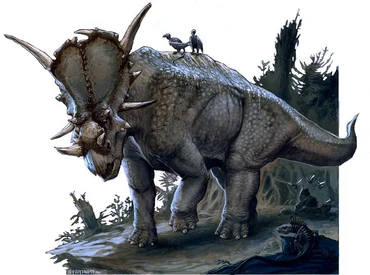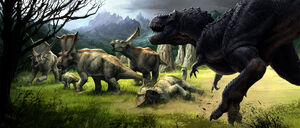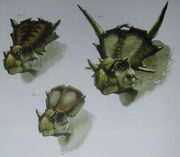
The Ferrucutus, Ferrucutus cerastes, is a large, powerful, competitive centrosaurine ceratopsid from the lowlands of Skull Island. It measures 24-34 feet long.
Among the most impressive herbivores on Skull Island are the mighty Ferrucutus. Heavily built grazers/browsers with massive shoulders and enormous frills of bone and spike, these powerful animals are dangerous prey for the island’s carnivores.
Despite their fearsome aspect and aggressive manner, Ferrucutus are exclusively herbivores, eating low shrubbery and using their nasal horns to uproot tall cycads to get to the fruit in the crown of the plants. Jungle cleared by Brontosaurus herds is quickly reduced to grassland by these shrub-browsing ceratopsids, their hard beaks making short work of the thorns and woody stems.
Ferrucutus herds can number up to around 12 individuals. Herds claim and defend small territories where eggs are laid, giving them time to develop in safety. Young immediately join the herd upon hatching and gain the protection of the group from such attackers as Lycaesaurus and pugbats. When threatened by a predator, even such a predator as Piranhadon if these herbivores are at a swamp, the herd instinctively closes around the young, presenting a ring of outward-facing horns and frills while the dominant male will then rush forward to challenge the intruder. Even the biggest and hungriest V. rex will think twice about tackling an enraged bull Ferrucutus.

Certainly a threat to would-be predators like Venatosaurus, the head armament of a Ferrucutus is primarily used in dominance fights between adult males contesting lordship of their small herds of females and young. Intensely territorial and pugnacious, adult bulls can grow to almost half again as large as a cow. They collect small harems and guard them jealously. Fights between males are frequent. Young bulls congregate in bachelor herds, honing their sparring skills with playful bouts until they are large and strong enough to challenge for their own harems.
Full dominance fights can be bloody, with injury not uncommon and death not unheard of. Even superficially wounded bulls can die of nasty infections later.
Skull Island dung beetles will follow herbivores like these and eat their feces.

Head Frills[]

“The larger the frill, the more senior the animal” seems to be the rule among the ceratopsians of Skull Island, especially with Ferrucutus. Starting out small in juveniles, the frills of the Ferrucutus grow throughout their lives, with the older individuals sporting huge and elaborate horned frills. Adult females have large frills and horns, but by far the most impressive arrays are those of the big adult males. Some bulls have horns over six feet long. In mature individuals, the face of the frill above the brows will change color in the breeding season to indicate readiness to mate. In some cases this display is enough to intimidate a competitor into giving up before any violence occurs. Among females, the secondary cheek horns are barely noticeable and the small horns at the center top of the frill rarely grow long enough to cross. Only the largest males develop a full crossover, and this is good measure of the age of the individual.
Skeletal Adaptations[]
With powerfully muscles shoulders and huge, heavy skulls, the skeletons of Ferrucutus are heavily reinforced. Huge forelimbs give them traction in head sparring and in uprooting stubborn plants. The neck is built to transmit impact from the skull and spreads it throughout the body, diffusing jolts as males fight. All the limbs are drawn directly under the body to support the animals’ sturdy physique.
Relationship with Skull Island Termites[]

Vertebrates like Ferrucutus actively provoke the Skull Island termites to swarm over their hides by rubbing themselves against mounds. While their own skins are tough enough to withstand the termites’ bites, unwelcome dermal parasites on the hides are not so lucky.
